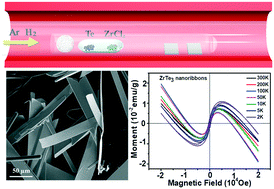Fast and controlled growth of two-dimensional layered ZrTe3 nanoribbons by chemical vapor deposition†
Abstract
Quasi-one-dimensional (1D)/two-dimensional (2D) ZrTe3 attracts intense interest as a typical charge density wave (CDW)-bearing material. However, the conventional chemical vapor transport (CVT) synthesis of bulk ZrTe3 is limited by high time consumption, even up to weeks, and low morphological controllability, so it is highly desirable to develop feasible methods for fast and controlled ZrTe3 growth, and so far, these have not been demonstrated. In this work, we first demonstrated that ZrTe3 nanoribbons can be grown directly by a modified chemical vapor deposition (CVD) method. The growth time is significantly reduced to less than 90 min, and the size of ZrTe3 nanoribbons can be well tuned by controlling the growth time and growth temperature. Moreover, differing from most of the other transition metal trichalcogenides (TMTCs), we reveal that ZrTe3 nanoribbons exhibit both competing and synergistic magnetic properties originating from their intrinsic diamagnetism and unexpected ferromagnetism, which can be attributed to their structural imperfection and edge-states due to the reduced dimensionality. Such observable ferromagnetism might favor the exploration of their spin-electronic applications.



 Please wait while we load your content...
Please wait while we load your content...